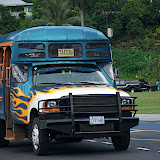I talk about how much I love the aiga buses, but today I was inspired by Mom’s aiga bus pictures to give you the full low down on our lovely, crazy, squishy bus system.
Aiga is Samoan for “family,” so the buses are not run by the government. Rather, individual families decide to purchase/make a bus and use it as a private business.
The look of the aiga buses is what makes them memorable. They are all made by using the front of a pick up truck. Wealthier families can afford to use a super-duty, but some buses are made from just the front/engine of a small toyota pick up. They fashion the rest of the bus to the pick up truck cab, and all of it is handmade. The inside of the buses are entirely wood and the roofs are made from long, curved pieces.The craftsmanship is pretty impressive. They are all open air but have simple plexi windows that you can slide up when it rains.
The inside and the outside of the buses are quite elaborate. Each gets a crazy paint job and a name scrolled across the side. The inside cab of the buses are decorated with everything from crazy printed fabrics, tassels, and boas. And about 20 pine tree air fresheners hang inside.
Riding a bus is quite an experience. In the morning and afternoons the buses get jam packed. The seats are small and 2 medium sized people could fit tightly; however they expect 2 Samoan sized rides to sit per seat. This usually means that the person on the aisle hands off half way. Bus drivers don’t always stop picking people up once the seats are full. There is a distinct seating hierarchy. Men move the back to make room for women, and the young move to the back to make from for the old. Once a bus is “full” kids move onto an adult’s lap. Once that has happened, teenagers move to each other’s laps. Finally new riders stand in the isles. When all is said and done, a village of people often fit on a single bus.
The crowds aren’t always great, but I still enjoy the ride. Aiga buses are famous for blaring Samoan music as they cruise across the island. There is nothing more fun than jamming to the tropical tunes and sitting with the wind in your face, and it is only a $1 to ride.
Unlike in the US, you can flag down a bus anywhere. There are bus stops for shade, but most people just wait along the road. To flag a bus you have to perform the secret hand signal. You raid your arm parallel to the ground and flick your wrist (sort of like an “ay hitler” motion). And ‘wha-la,’ the bus pulls over.
So how do you know which bus to get on? Well, there is only one main road on the island. Then, there a smaller roads that branch off towards different villages. The buses are either west side or east side, and they all merge in central Fagatogo for transfers. Each bus has a village name in the window, so you know that is where it is headed and the displayed village is the last stop. (Too and from school I take either an Amanave or Leone bus).


No comments:
Post a Comment